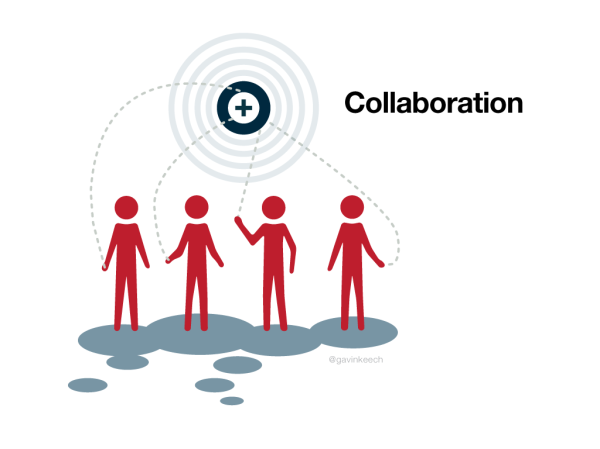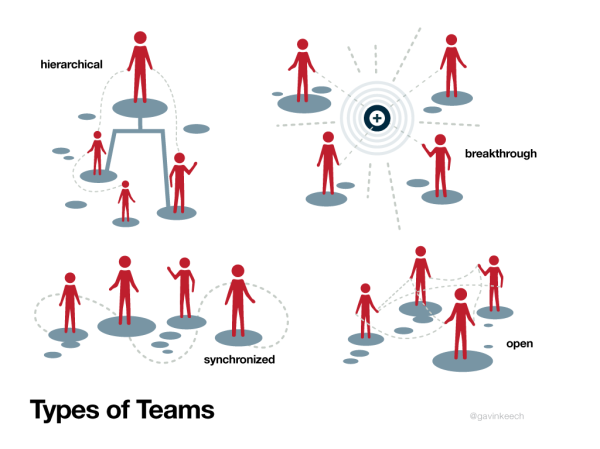
I’m in the middle of taking a course on Virtual Learning Environments (syllabus here), and reading a few chapters from Adaptive Software Development by Highsmith. It approaches the team-building and collaboration process from the perspective of complex adaptive systems theory, and contains some interesting insights in evolutionary development and creating environments where emergence can occur. I’ve created a summary of a chapter that I’d like to share, as I think it can be valuable for many of us, and specifically for the community of practitioners around the junto concept.
Collaboration is an act of shared creation or discovery. (schrage89)
As a distributed group of individuals (agents) within a network, we form a complex adaptive system. The key to our success is in creating the environment where emergent, innovative results can occur.

- Barriers to Collaboration
1. A top down Command+Control management style
This style works well for organizations that operate effectively by regarding their people as interchangeable cogs in a machine – following specific rules in a predictable environment which is structured hierarchically. An emergent, adaptive group does not exude these characteristics.
2. An over-reliance on the culture of individualism & attitude of “every man for himself”
It is a challenge to collaborate effectively, when many of our current organizational models still reward individual rather than group performance. BUT, collaboration is about mutual creation.
As we design new systems, it will be important to frame the experience in a way that values and rewards productive participation and contribution.
(This relates well to the component mentioned in yesterday’s junto post on creating an opportunity for rating/evaluating each other’s participation in dialogues…. and structured in a way that is generative and encouraging of paths to improvement, not putting people down for lack of experience or technique.)

- The Essence of Great Groups
A team consists of…
… a small number of people with complementary skills who are committed to a common purpose, performance goals, and [a common] approach for which they hold themselves mutually accountable. (J. Katzenbach & D.Smith)
Successful, innovative teams are all about the relationships and the right blend of skills – technical, business, problem-solving, decision-making, and interpersonal. They all work towards a common goal, but are alo committed to a deeper purpose. Through the process of building trust, each individual assumes a level of risk that is associated with assuming personal responsibility and mutual accountability.
Four types of teams and the environment in which they work best:
Traditional hierarchical: territory is familiar & predictable, requirements well-known
Breakthrough: project must develop major new innovation. environment chaotic & random, project structures become very unstable as they grow larger
Synchronized: project success dependent on shared vision and common values. effectiveness requires full commitment by all members to a sufficiently complex vision of mission and methods of group
Open: territory is turbulent & fluid, success requires an open-ended, flexible apporach. “Adaptive collaboration is tailored for technical problem-solving… What is important in this view of projects and progress is the adaptive fit between how the team is working and what it is they are working on” (op.cit. p.72)
“While a breakthrough team structure would work for a small adaptive project, my view is that open teams are the most appropriate for adaptive projects in general – for two reasons. First, adaptive development requires the ability to scale up to larger, more complex projects – and open teams can do this. Breakthrough organizations work bet with a small, collocated team. Second, a breakthrough organization is an excellent choice for creative inventions (in science, for example), but less suitable for the work of turning a creation into a complete product, such as in engineering. So, while there are exceptions to every rule, an open organization seems best for adaptive projects. Collegiality flourishes in open environments.”
- Using Complexity Concepts to Improve Collaboration
In complex adaptive systems theory, the focus is on the concept of emergence. Ralph Stacy has identified five control parameters characteristic of networks that determine whether the group/organization is on the edge of chaos:
1. Rate of Information Flow
Restriction of the speed of information flow can be detrimental to a team in a rapidly changing environment. There are two fundamental kinds of interactions the team must differentiate between – shared creation and information transfer.
- Shared Creation
– These are meetings focused on brainstorming, problem-solving, decision-making, or reacting & evaluating (feedback). This type of process creates value through active collaboration.
- Information Transfer
– The purpose of these meetings is to inform. The format is reporting and presentation, and the information is not intended to be modified or updated.
2. Degree of Diversity
A diversity of technical skills and experience, cultural and racial backgrounds, personality types and temperaments, business skills and experience, all contribute to a healthy mix in the creative process. Too much diversity can create issues in creating collaborative environments and facilitating convergence in order to produce results.
3. Richness of Connectivity
This refers to both the number of connections between people in a group (“network weaving”) as well as the type of data flow (text, imagery, sound). Increasing the number of interconnected groups increases diversity of information exchanged in problem solving.
4. Level of Contained Anxiety
“Complexity theory supports the view that anxiety is a cauldron for creativity.” Innovative groups are able to strike the balance and ride the edge of chaos, existing between high tension/anxiety and stagnantion/inertia.
5. Degree of Power Differentials
While open collaboration encourages participation and empowerment, it also must find a balance between a Command-Control management style and no leadership at all.
- Building Collaborative Groups
Cooperation in networked environments isn’t about learning how to use “collaboration tools,” it’s about learning how to communicate effectively and resolve interpersonal issues.
The beginnings of a conversation may start with everyone wanting to express their own opinions and be heard. As the conversation progresses, individuals make an effort to understand each others’ perspectives, reasons, assumptions, and mental models. Adaptive cycles require teams to make this transition from divergent to convergent thinking in order to form “sustainable agreement” and move forward with deliverables.
- Core Values
Successful collaboration in a self-organizing team is facilitated when core values are embraced and demonstrated in daily encounters. The core values are mutual trust, mutual respect, and mutual participation, and mutual commitment.
- Mutual Trust
There are three components of trust:
- Honesty: telling the truth
- Safety: an ability to voice ideas an opinions without fear of ridicule or rejection
- Dependability: knowing others will accomplish the tasks assigned to them
Trust levels are always in flux, but are built up by “showing respect to others, doing what we commit ourselves to do, being honest and forthright in our dealing, and by not playing politics.” Trust is not a replacement for accountability – others must still be held accountable in order to protect against miscommunication or flawed expectations.
-
Mututal Respect
It’s easy to full tuned to the people in our group that think like us. The challenge is to value others for their unique contributions, despite our understanding of their area of expertise.
-
Mutual Participation
Every team member should have the freedom to express themselves, and the commitment of the team to understand that particular perspective. Though every member will not contribute equally, each must have the ability to contribute in key ways.
- Mutual Commitment
Everyone in the group is committed to achieving the purpose and goals of the project, shares responsibility for making it happen, and owns the result.
-
Joint Application Development (JAD) Sessions
JADs are:
“a facilitated workshop that brings together cross-functional groups to build collaborative relationships capable of producing high-quality deliverables during the life of a project.”
These sessions are feed-forward rather than feedback, meaning they are intended to solve problems, plan later work, and make decisions. There are four key roles in a JAD session: project manager, participants, facilitator, and scribe. Project managers are responsible for group administration. Facilitators plan the session with the project manager, orchestrate interactions during the meeting, assist in preparing documentation, and expedite follow-up after the session. Participants are responsible for the contents of the agreed-upon deliverable. The scribe documents the session – gathering, organizing, and distributing the results.
Assuming roles also enhances collaboration, helps team members evaluate mission components, and allows them to experiment with different identity constructs. Role-playing is both fun and sparks creativity. Three sample roles are visionary, realist, and critic. A visionary can switch between many roles and see the big picture, a realist can break things down to their components and form plans of action, and a critic anticipates problems and risks.
-
Techniques for Successful JADs
-
Prepare
Each session must have a solid objective and an agenda following that objective, so that participants come prepared to meet the expectations. An example of a contructive JAD session is to explore and define the project’s mission. Another necessary objective is relationship-building, which is crucial for forming emergent environments. More important than any single deliverable is understanding everyone’s mental models. For instance, if the topic is about a product’s “quality,” sufficient time must be spent uncovering and analyzing each person’s view of what that word means.
-
Conducting the Session
This is a matter of deciding who talks when, and keeping the discussion focused.
-
Produce the Documents
There must be a “product” at the end of the session that can be archived and available for future reference.
-
Stable Change
“Collaboration is the best tool for dealing with high-change environments.”
The characteristics that enable individuals and organizations to embrace change can be defined as “resilience.” Three keys are:
-
1. Establish respect and trust for leaders
Unlike the emphasis positional power common in hierarchical organizations, trust and respect are the glue of an adaptive system.
2. Build strong relationships
In a self-organizing environment, strong relationships are essential for collaboration.
-
3. Instill confidence in technical skills
Though the tools may change, confidence in one’s capabilities will carry them through rough spots and challenges.
-
Summary
I really enjoyed this overview, and found that we have already come to many of these conclusions through our experimentation and intuition. I’ve been writing for months about the trust-building and relationship-building process in networked environments, and the need to dissolve illusions of the ego and become more open-hearted and open-minded. Much of the information from this chapter affirmed those ideas. I found the section about the 5 “levers” that push teams to the creative edge fascinating, and those control parameters definitely personally resonated with my experience. As we’ve discussed the two tracks for junto discussions – freeform and structured – I saw a lot of parallels between what they called feed-forward and feedback JAD sessions. The suggestion for role-playing in discussions was also aligned with our thoughts on creating roles for discussions, what we defined as host/facilitator, participants, and mapper. I’m really interested now to explore self-definition and roles in this process, and experiment with different combinations of personalities and strengths to see what kind of creativity emerges.
Venessa Miemis
One thought on “Guidelines for Group Collaboration and Emergence”
Comments are closed.